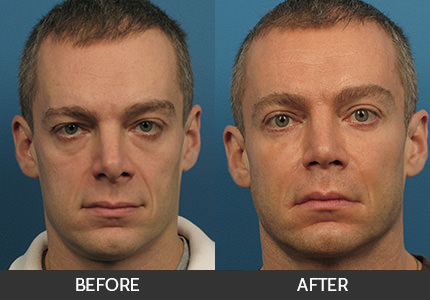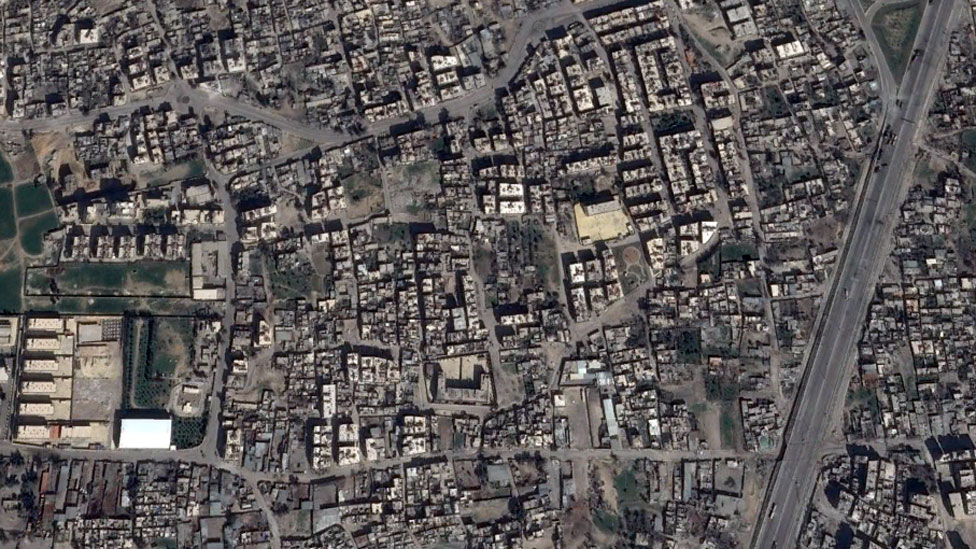/arc-anglerfish-syd-prod-nzme.s3.amazonaws.com/public/72IPSPP465EFVAW3FXCFWETPQA.jpg)
Most men have, at one time or another, looked in the mirror and made a mental list of the imperfections they see. Ears that stick out too far from the side of our heads. Lines that weren’t there before fatherhood. Love handles that weren’t there before 30. The jowls, the blotches, the hairlines on a full-scale retreat.
We all have them. It would be nice to view them as marks of experience, like the patina on a gracefully aged leather jacket, but more men than ever are taking a more radical approach. Cosmetic surgery for men has never been more available or affordable, with more of us willing to go under the knife and/or laser to improve our looks.
Men may only account for around 10 per cent of cosmetic surgery procedures carried out in the UK today (according to stats from the British Association of Aesthetic Plastic Surgeons), but it’s still a significant number who are at least open to the idea of having a little ‘work’ done.
According to BAAPS, though, we’re moving away from radical procedures and towards more minor ‘tweakments’ – attempting to enhance what we already have, rather than trying to build again from scratch, so to speak.
“Men want to look good for their age nowadays, especially as there seems to be more competitive in the workplace,” says Bernadette Harte from The Harley Medical Group. According to Harte, eyelid surgery is the most common procedure with middle-aged men, while younger men tend to want fat removed, most commonly from their chests.
Considering going under the knife? Then you should at least be informed. We spoke to leaders in the industry to get the low-down on the most popular types of cosmetic surgery for men – from what procedures involve, to how much they’ll set you back. As with any reasonably invasive means of improving your appearance, it pays to know the facts.
Plastic Surgery For Men: What To Know First
Any cosmetic procedure – from the smallest tweak to the most invasive procedure – involves risk. If you’re thinking about having cosmetic surgery, do your research first and, if possible, consult a surgeon on the basis of a recommendation.
According to Save Face, the national register for professionals who carry out things like fillers and Botox, the number of complaints regarding botched procedures has risen dramatically; leading the UK government to launch a campaign in England to tackle cosmetic treatments that go wrong.
“Always ask about revision rates (the cost of tweaks potentially needed after the op if you’re not happy with the results) and the amount of experience a surgeon has had doing a specific procedure is particularly important,” says Harte.
Finally, beware overseas bargain procedures. Enquiries about hair transplants to overseas clinics in countries like India and Turkey have climbed by over 150 per cent in recent years, and while it can be economical, it’s vital you research the clinic thoroughly and think about how you’d organise aftercare while abroad if needed.
To find a surgeon in the UK, see the British Association of Aesthetic Plastic Surgeons website at baaps.org.uk.
Plastic Surgery For Men: Popular Procedures
Rhinoplasty (Nose Job)
Rhinoplasty, or to give it its colloquial name, the nose job, is one of the most common aesthetic surgeries in the world and – with over a thousand performed every year – one of the most popular with men in the UK.
Why?
Some guys are simply unhappy with the nose the big man gave them, while others book in for the procedure to correct a nose broken in an accident, or as a result of a sports-related injury.
How?
A fairly straightforward procedure, the rhinoplasty operation is carried out inside the nose, so no scars are visible following the surgery. An incision is made inside the nostrils, which allows access to the bones and cartilage beneath. The surgeon then reshapes the bone and cartilage – either removing some or adding tissue to the area – before folding the skin back over the new framework, changing the size and shape of the nose.
The operation usually takes around two hours, requiring a local anaesthetic and an overnight stay in hospital. While the op itself is relatively quick, you can expect signs of the procedure to linger for a while.
“Bruising is very individual,” says Harte. “It usually tends to last about 10 days post-rhinoplasty, though some people may not experience any bruising at all – just mild redness.” It’ll also take a while for the final result of the rhinoplasty to be fully visible: “It can take the nose a year to look its best,” she says.
Prices vary but expect to pay around £3,000-£5,000 depending on whether you just want a small alteration or a more extensive overhaul.

Hair Transplant
Hair transplants officially came out of the cosmetic closet the moment former Manchester United and England striker Wayne Rooney tweeted about his stint in the surgical suite.
Rooney’s not alone, either. With 40 per cent of under-35-year-olds already going thin on top, there’s a sizeable market out there for transplants. The Dr Medispa clinic in London and Essex says it carries out around 700 procedures of this kind every year.
Why?
Some guys embrace male pattern baldness – and props to them – but for others, thinning hair can negatively affect their self-esteem. A hair transplant can help achieve fuller locks and boost self-confidence.
How?
The procedure Rooney opted for – and the most popular form of transplant – Follicular Unit Extraction (FUE), is a much less invasive treatment than previous techniques. It involves removing individual hairs from the back or side of the head (or the chest if you’re already too thin on top for hair to be harvested from your bonce) and implanting them elsewhere on your scalp, usually where hairs once grew.
Carried out under local anaesthetic, the procedure takes around eight hours (remember to pack a good book) and costs around £10,000. “FUE is simple, minimally invasive and there are no stitches or obvious scars,” says Dr Raghu Reddy of The Private Clinic of Harley Street.
Since the more hair you’ve lost, the more the procedure is likely to cost, Reddy advises addressing the issue sooner rather than later. If you leave it until you look like Jean-Luc Picard, you’ve probably left it a little too late.
Also, bear in mind that one FUE procedure may not permanently solve thinning hair problems. If you are predisposed to baldness, you will almost certainly have to undergo repeat procedures as often as every couple of years to fend off hair loss; Rooney, for example, has already had at least two treatments that we know of.

Beard Transplant
Given the popularity of facial hair – and some men’s disappointment at what, if anything, emerges from their chins when they try to grow some – it was inevitable that beard transplants would grow in popularity once the craze really kicked in.
In fact, according to a poll by WhatClinic.com, surgeons saw a 72 per cent rise in enquiries about beard transplants in 2014. There was a 21 per cent increase in enquiries about pubic hair transplants too, but let’s leave that one for another time.
Why?
A transplant is a long-term solution to a patchy beard. Or maybe you have very little facial fuzz and just want a bushier, thicker beard.
How?
Like Follicular Unit Extraction, individual hairs are extracted from the hair at the back of the scalp (body hair can also be used) and replanted, one by one, where they’re needed most.
A full beard requires around 4,000 hairs to be transplanted while a goatee needs around 1,500. It’s expensive (expect to pay between £3,000-£6,000) and time-consuming (taking between three and nine hours) but the results, which will need several months to bed in, can look great and scarring is minimal.
Worth considering if you’re hung up on your patchy (or non-existent) beard, but probably not best advised if you’re only interested in jumping on the current beard bandwagon.

Liposuction
Even with the strictest of training regimes, it can be hard to shift fat that’s covering muscle and acting as a great wall between you and your summer body. Variants of liposuction have for a long time been an increasingly popular way for individuals wanting a six-pack and more contoured stomachs.
Why?
Sometimes there are stubborn pockets of fat that no amount of dieting and exercise seems to shift. Fat removal techniques like Liposelection and Coolsculpting offer a fast and effective solution to love handles and more.
How?
If you’ve seen liposuction in action, you’ll know it’s basically a procedure where fat is sucked out of the body using a tube.
“Usually the men that come to see me are in their thirties or forties, and they’re from all walks of life – from office workers and city boys to labourers,” says Harley Street Surgeon Dr Roberto Viel from the London Centre for Aesthetic Surgery.
Gentler and less invasive, Liposelection offers a precise way of removing small pockets of fat from the abdomen, neck and chin. The procedure uses ultrasound waves to break up fat while leaving other tissues undamaged. The broken-up fat is then removed with a small tube as part of a local anaesthetic procedure that can take as little as an hour.
“Because this type of surgery removes fat but leaves your other tissues intact, your skin retracts smoothly and evenly after the procedure, and pain and bruising typically associated with fat removal is minimised,” says Dr Veil.
To figure out how Coolsculpting works, you only have to look at its more colloquial name: fat freezing. “A machine freezes the fat cells so that they die and are permanently removed by the body,” explains Dr Jonquille Chantrey, who has more than 10 years of plastic and cosmetic surgery experience. “This is FDA (Food and Drug Administration) approved, and there are no needles, surgery or scalpels involved.”
Less invasive options are typically cheaper (starting at around £1,500 for Coolsculpting) and recovery time is quicker: days, rather than the weeks sometimes required following a traditional liposuction procedure.

Blepharoplasty (Eyelid Surgery)
Especially popular with guys in middle age, blepharoplasty is an operation to get rid of droopy eyelids or any ‘excess ocular luggage’ you might be carrying.
Why?
Few things age a man quite like his peepers. If eyes are the windows to the soul and a fresh pair of curtains can knock years off and stave off issues like itchy and flaky skin.
How?
“People often comment [with regard to their own appearance] that they look tired, when in fact it’s the excess skin and obvious fat pads that make them tired-looking,” says Harte.
To counteract this, small incisions are made in the natural folds of the eyelids to remove excess skin and fatty tissue that cause hooded eyes or eye bags. The procedure can also be used to reduce the appearance of crow’s feet.
It takes around one to three hours, costs upwards of £3,000, and you’ll need around a week’s recovery time.
However, if the appearance of looking tired comes from the overall impression of the face, not just the eye area (dark circles, sunken cheeks, loss of the jawline etc.), a blepharoplasty alone won’t fix this. Instead, Chantrey recommends seeking out a treatment aimed at lifting and tightening the face as a whole, including the eyes, such as a non-invasive facelift.

Otoplasty (Ear Pinning)
With one in 20 Brits convinced their ears stick out too much, ear correction, or otoplasty, has become one of the most popular procedures with men. A relatively simple operation, it involves a re-sculpting of the cartilage at the back of the ear to reposition the ear or bring it a little closer to the head.
Why?
Some people simply aren’t happy with the shape of their ears, while others may have suffered an injury that cosmetically affected the appearance of their lugs.
How?
An incision is made at the back of the ear – in a fold that makes any scar difficult to see – to expose the cartilage. The cartilage is then re-shaped or partially removed, allowing the ear to adopt a more regular position.
The procedure takes around one to two hours, is usually performed under a local anaesthetic and costs in the region of £3,000+. Results are usually good, but cartilage can change over time, affecting the results.
The biggest downside to undergoing an otoplasty is that you’ll have to wear a head bandage for around a week afterwards, so you might want to consider taking advantage of some of that annual leave.

Botox (‘Brotox’)
Botox was first approved as a cosmetic by the FDA in April 2002 as a temporary way of improving frown lines. Now more than a decade old, it continues to be seen as one of the biggest breakthroughs in anti-ageing ever.
Why?
As far as terrible portmanteaus go, ‘Brotox’ is up there with ‘mewellery’ and ‘mankles’. However, inspired by TV shows and celebrities such as David Beckham, a growing number of men are turning to these injections to hold back the march of time.
How?
As alien as the idea of having a toxin designed to cause paralysis injected into your face sounds, Botox (as it’s known as a brand) is a proven way of reducing lines and wrinkles.
It does this by blocking signals from the nerves to the muscles. The injected muscle can no longer contract, making things like crow’s feet and frown lines less obvious.
According to BAAPS, facial procedures for men are up around 15 per cent, with most looking for a more chiselled appearance, or wanting to look more or less masculine.
“It has now become so acceptable that men are having it increasingly,” says Botox specialist Dr Jules Nabet. “Over 25 per cent of my Botox customers are now men, as opposed to 1 per cent 10 years ago”.
One of the main benefits of Botox is that the procedure only takes a few minutes, and no anaesthesia is required, meaning downtime is limited.
However, it generally takes three to seven days to take full effect, and temporary bruising and headaches can occur within the first 24-48 hours. Plus, at a cost of £150-£350 per session, and only lasting between four and six months, it can quickly become an expensive habit to maintain.

Botulinum Toxin (Excessive Sweating Treatment)
Botulinum is the scientific name for Botox, and as well as being used to smooth out faces, it’s also employed for the slightly less glamorous task of blocking sweat glands.
This is most commonly done in cases of Hyperhidrosis (aka excessive sweating), which affects at least 3 per cent of the UK population.
Why?
If lifestyle changes such as wearing quality leather shoes or using a deodorant containing aluminium chloride don’t help with Hyperhidrosis, a dermatologist is likely to suggest Botulinum injections to stem the flow of sweat.
How?
Just as Botox blocks signals to the muscles, Botulinum injections block communication between the brain and any overactive sweat glands in the body. These are usually found in the hands, feet and armpits of sufferers, but can also appear elsewhere such as the back and forehead.
According to Dr Munir Somji, chief medical officer at Dr MediSpa, the use of toxins like Botulinum by men to reduce issues such as excessive sweating has increased by 60 per cent in the last year.
Depending on the severity of the case, as many as 20 injections are given in the affected areas, a process that takes around 30-45 minutes and, like cosmetic Botox, the results last several months.
Fortunately, the procedure is available on the NHS, though can also be carried out privately with treatment costs starting from around £150 for the forehead and £450 for both armpits.

MEN’S GROOMING TIPS & MALE GROOMING
Plastic Surgery For Men: Everything You Need To Know
The why, how, and how much of nips and tucks from your nose to your nutsack
BY FASHIONBEANS EDITORS
Most men have, at one time or another, looked in the mirror and made a mental list of the imperfections they see. Ears that stick out too far from the side of our heads. Lines that weren’t there before fatherhood. Love handles that weren’t there before 30. The jowls, the blotches, the hairlines on a full-scale retreat.
We all have them. It would be nice to view them as marks of experience, like the patina on a gracefully aged leather jacket, but more men than ever are taking a more radical approach. Cosmetic surgery for men has never been more available or affordable, with more of us willing to go under the knife and/or laser to improve our looks.
Men may only account for around 10 per cent of cosmetic surgery procedures carried out in the UK today (according to stats from the British Association of Aesthetic Plastic Surgeons), but it’s still a significant number who are at least open to the idea of having a little ‘work’ done.
According to BAAPS, though, we’re moving away from radical procedures and towards more minor ‘tweakments’ – attempting to enhance what we already have, rather than trying to build again from scratch, so to speak.
“Men want to look good for their age nowadays, especially as there seems to be more competitive in the workplace,” says Bernadette Harte from The Harley Medical Group. According to Harte, eyelid surgery is the most common procedure with middle-aged men, while younger men tend to want fat removed, most commonly from their chests.
Considering going under the knife? Then you should at least be informed. We spoke to leaders in the industry to get the low-down on the most popular types of cosmetic surgery for men – from what procedures involve, to how much they’ll set you back. As with any reasonably invasive means of improving your appearance, it pays to know the facts.
Plastic Surgery For Men: What To Know First
Any cosmetic procedure – from the smallest tweak to the most invasive procedure – involves risk. If you’re thinking about having cosmetic surgery, do your research first and, if possible, consult a surgeon on the basis of a recommendation.
According to Save Face, the national register for professionals who carry out things like fillers and Botox, the number of complaints regarding botched procedures has risen dramatically; leading the UK government to launch a campaign in England to tackle cosmetic treatments that go wrong.
“Always ask about revision rates (the cost of tweaks potentially needed after the op if you’re not happy with the results) and the amount of experience a surgeon has had doing a specific procedure is particularly important,” says Harte.
Finally, beware overseas bargain procedures. Enquiries about hair transplants to overseas clinics in countries like India and Turkey have climbed by over 150 per cent in recent years, and while it can be economical, it’s vital you research the clinic thoroughly and think about how you’d organise aftercare while abroad if needed.
To find a surgeon in the UK, see the British Association of Aesthetic Plastic Surgeons website at baaps.org.uk.
Plastic Surgery For Men: Popular Procedures
Rhinoplasty (Nose Job)
Rhinoplasty, or to give it its colloquial name, the nose job, is one of the most common aesthetic surgeries in the world and – with over a thousand performed every year – one of the most popular with men in the UK.
Why?
Some guys are simply unhappy with the nose the big man gave them, while others book in for the procedure to correct a nose broken in an accident, or as a result of a sports-related injury.
How?
A fairly straightforward procedure, the rhinoplasty operation is carried out inside the nose, so no scars are visible following the surgery. An incision is made inside the nostrils, which allows access to the bones and cartilage beneath. The surgeon then re-shapes the bone and cartilage – either removing some or adding tissue to the area – before folding the skin back over the new framework, changing the size and shape of the nose.
The operation usually takes around two hours, requiring a local anaesthetic and an overnight stay in hospital. While the op itself is relatively quick, you can expect signs of the procedure to linger for a while.
“Bruising is very individual,” says Harte. “It usually tends to last about 10 days post-rhinoplasty, though some people may not experience any bruising at all – just mild redness.” It’ll also take a while for the final result of the rhinoplasty to be fully visible: “It can take the nose a year to look its best,” she says.
Prices vary but expect to pay around £3,000-£5,000 depending on whether you just want a small alteration or a more extensive overhaul.
Rhinoplasty
Hair Transplant
Hair transplants officially came out of the cosmetic closet the moment former Manchester United and England striker Wayne Rooney tweeted about his stint in the surgical suite.
Rooney’s not alone, either. With 40 per cent of under-35-year-olds already going thin on top, there’s a sizeable market out there for transplants. The Dr Medispa clinic in London and Essex says it carries out around 700 procedures of this kind every year.
Why?
Some guys embrace male pattern baldness – and props to them – but for others, thinning hair can negatively affect their self-esteem. A hair transplant can help achieve fuller locks and boost self-confidence.
How?
The procedure Rooney opted for – and the most popular form of transplant – Follicular Unit Extraction (FUE), is a much less invasive treatment than previous techniques. It involves removing individual hairs from the back or side of the head (or the chest if you’re already too thin on top for hair to be harvested from your bonce) and implanting them elsewhere on your scalp, usually where hairs once grew.
Carried out under local anaesthetic, the procedure takes around eight hours (remember to pack a good book) and costs around £10,000. “FUE is simple, minimally invasive and there are no stitches or obvious scars,” says Dr Raghu Reddy of The Private Clinic of Harley Street.
Since the more hair you’ve lost, the more the procedure is likely to cost, Reddy advises addressing the issue sooner rather than later. If you leave it until you look like Jean-Luc Picard, you’ve probably left it a little too late.
Also, bear in mind that one FUE procedure may not permanently solve thinning hair problems. If you are predisposed to baldness, you will almost certainly have to undergo repeat procedures as often as every couple of years to fend off hair loss; Rooney, for example, has already had at least two treatments that we know of.
Hair Transplant
Beard Transplant
Given the popularity of facial hair – and some men’s disappointment at what, if anything, emerges from their chins when they try to grow some – it was inevitable that beard transplants would grow in popularity once the craze really kicked in.
In fact, according to a poll by WhatClinic.com, surgeons saw a 72 per cent rise in enquiries about beard transplants in 2014. There was a 21 per cent increase in enquiries about pubic hair transplants too, but let’s leave that one for another time.
Why?
A transplant is a long-term solution to a patchy beard. Or maybe you have very little facial fuzz and just want a bushier, thicker beard.
How?
Like Follicular Unit Extraction, individual hairs are extracted from the hair at the back of the scalp (body hair can also be used) and replanted, one by one, where they’re needed most.
A full beard requires around 4,000 hairs to be transplanted while a goatee needs around 1,500. It’s expensive (expect to pay between £3,000-£6,000) and time-consuming (taking between three and nine hours) but the results, which will need several months to bed in, can look great and scarring is minimal.
Worth considering if you’re hung up on your patchy (or non-existent) beard, but probably not best advised if you’re only interested in jumping on the current beard bandwagon.
Beard Transplant
Liposuction
Even with the strictest of training regimes, it can be hard to shift fat that’s covering muscle and acting as a great wall between you and your summer body. Variants of liposuction have for a long time been an increasingly popular way for individuals wanting a six-pack and more contoured stomachs.
Why?
Sometimes there are stubborn pockets of fat that no amount of dieting and exercise seems to shift. Fat removal techniques like Liposelection and Coolsculpting offer a fast and effective solution to love handles and more.
How?
If you’ve seen liposuction in action, you’ll know it’s basically a procedure where fat is sucked out of the body using a tube.
“Usually the men that come to see me are in their thirties or forties, and they’re from all walks of life – from office workers and city boys to labourers,” says Harley Street Surgeon Dr Roberto Viel from the London Centre for Aesthetic Surgery.
Gentler and less invasive, Liposelection offers a precise way of removing small pockets of fat from the abdomen, neck and chin. The procedure uses ultrasound waves to break up fat while leaving other tissues undamaged. The broken-up fat is then removed with a small tube as part of a local anaesthetic procedure that can take as little as an hour.
“Because this type of surgery removes fat but leaves your other tissues intact, your skin retracts smoothly and evenly after the procedure, and pain and bruising typically associated with fat removal is minimised,” says Dr Veil.
To figure out how Coolsculpting works, you only have to look at its more colloquial name: fat freezing. “A machine freezes the fat cells so that they die and are permanently removed by the body,” explains Dr Jonquille Chantrey, who has more than 10 years of plastic and cosmetic surgery experience. “This is FDA (Food and Drug Administration) approved, and there are no needles, surgery or scalpels involved.”
Less invasive options are typically cheaper (starting at around £1,500 for Coolsculpting) and recovery time is quicker: days, rather than the weeks sometimes required following a traditional liposuction procedure.
Liposuction
Blepharoplasty (Eyelid Surgery)
Especially popular with guys in middle age, blepharoplasty is an operation to get rid of droopy eyelids or any ‘excess ocular luggage’ you might be carrying.
Why?
Few things age a man quite like his peepers. If eyes are the windows to the soul and a fresh pair of curtains can knock years off and stave off issues like itchy and flaky skin.
How?
“People often comment [with regard to their own appearance] that they look tired, when in fact it’s the excess skin and obvious fat pads that make them tired-looking,” says Harte.
To counteract this, small incisions are made in the natural folds of the eyelids to remove excess skin and fatty tissue that cause hooded eyes or eye bags. The procedure can also be used to reduce the appearance of crow’s feet.
It takes around one to three hours, costs upwards of £3,000, and you’ll need around a week’s recovery time.
However, if the appearance of looking tired comes from the overall impression of the face, not just the eye area (dark circles, sunken cheeks, loss of the jawline etc.), a blepharoplasty alone won’t fix this. Instead, Chantrey recommends seeking out a treatment aimed at lifting and tightening the face as a whole, including the eyes, such as a non-invasive facelift.
Blepharoplasty
Otoplasty (Ear Pinning)
With one in 20 Brits convinced their ears to stick out too much, ear correction, or otoplasty, has become one of the most popular procedures with men. A relatively simple operation, it involves a re-sculpting of the cartilage at the back of the ear to reposition the ear or bring it a little closer to the head.
Why?
Some people simply aren’t happy with the shape of their ears, while others may have suffered an injury that cosmetically affected the appearance of their lugs.
How?
An incision is made at the back of the ear – in a fold that makes any scar difficult to see – to expose the cartilage. The cartilage is then re-shaped or partially removed, allowing the ear to adopt a more regular position.
The procedure takes around one to two hours, is usually performed under a local anaesthetic and costs in the region of £3,000+. Results are usually good, but cartilage can change over time, affecting the results.
The biggest downside to undergoing an otoplasty is that you’ll have to wear a head bandage for around a week afterwards, so you might want to consider taking advantage of some of that annual leave.
Otoplasty
Botox (‘Brotox’)
Botox was first approved as a cosmetic by the FDA in April 2002 as a temporary way of improving frown lines. Now more than a decade old, it continues to be seen as one of the biggest breakthroughs in anti-ageing ever.
Why?
As far as terrible portmanteaus go, ‘Brotox’ is up there with ‘jewellery’ and ‘ankles’. However, inspired by TV shows and celebrities such as David Beckham, a growing number of men are turning to these injections to hold back the march of time.
How?
As alien as the idea of having a toxin designed to cause paralysis injected into your face sounds, Botox (as it’s known as a brand) is a proven way of reducing lines and wrinkles.
It does this by blocking signals from the nerves to the muscles. The injected muscle can no longer contract, making things like crow’s feet and frown lines less obvious.
According to BAAPS, facial procedures for men are up around 15 per cent, with most looking for a more chiselled appearance, or wanting to look more or less masculine.
“It has now become so acceptable that men are having it increasingly,” says Botox specialist Dr Jules Nabet. “Over 25 per cent of my Botox customers are now men, as opposed to 1 per cent 10 years ago”.
One of the main benefits of Botox is that the procedure only takes a few minutes, and no anaesthesia is required, meaning downtime is limited.
However, it generally takes three to seven days to take full effect, and temporary bruising and headaches can occur within the first 24-48 hours. Plus, at a cost of £150-£350 per session, and only lasting between four and six months, it can quickly become an expensive habit to maintain.
Botox for men
Botulinum Toxin (Excessive Sweating Treatment)
Botulinum is the scientific name for Botox, and as well as being used to smooth out faces, it’s also employed for the slightly less glamorous task of blocking sweat glands.
This is most commonly done in cases of Hyperhidrosis (aka excessive sweating), which affects at least 3 per cent of the UK population.
Why?
If lifestyle changes such as wearing quality leather shoes or using a deodorant containing aluminium chloride don’t help with Hyperhidrosis, a dermatologist is likely to suggest Botulinum injections to stem the flow of sweat.
How?
Just as Botox blocks signals to the muscles, Botulinum injections block communication between the brain and any overactive sweat glands in the body. These are usually found in the hands, feet and armpits of sufferers, but can also appear elsewhere such as the back and forehead.
According to Dr Munir Somji, chief medical officer at Dr MediSpa, the use of toxins like Botulinum by men to reduce issues such as excessive sweating has increased by 60 per cent in the last year.
Depending on the severity of the case, as many as 20 injections are given in the affected areas, a process that takes around 30-45 minutes and, like cosmetic Botox, the results last several months.
Fortunately, the procedure is available on the NHS, though can also be carried out privately with treatment costs starting from around £150 for the forehead and £450 for both armpits.
Botulinum Toxin (Excessive Sweating Treatment)
Scrotoplasty
Just about got your head around manscaping? Good, now it’s time to talk about scrotal lifts. No, we’re not pulling your… yeah. Scrotoplasty surgery is on the rise in the UK amongst body-conscious men.
Why?
If your answer to ‘how’s it hanging?’ is ‘a little too low’, a scrotal lift can help remove excess and saggy skin on the testicles.
How?
Though you might not have heard of it, a scrotoplasty is not something invented to steal money from Hollywood A-listers who are worried about their slack scrotums. The surgery was originally used to restore the scrotum after cancer or injuries but somehow, having a scalpel near your member has taken on mass-market appeal.
The procedure involves slicing away excess skin, then rejoining the muscle at the seam of the scrotum to reduce scarring.
It can be performed for around £2,800 under local anaesthetic in as little as 90 minutes, with patients able to leave the clinic the same day.
While there are no official stats on how many men are opting to get uplifted, it’s thought to be growing at the same rate as women getting labial reductions, with enquiries increasing 169 per cent in 2016.

MEN’S GROOMING TIPS & MALE GROOMING
Plastic Surgery For Men: Everything You Need To Know
The why, how, and how much of nips and tucks from your nose to your nutsack
BY FASHIONBEANS EDITORS
Most men have, at one time or another, looked in the mirror and made a mental list of the imperfections they see. Ears that stick out too far from the side of our heads. Lines that weren’t there before fatherhood. Love handles that weren’t there before 30. The jowls, the blotches, the hairlines on a full-scale retreat.
We all have them. It would be nice to view them as marks of experience, like the patina on a gracefully aged leather jacket, but more men than ever are taking a more radical approach. Cosmetic surgery for men has never been more available or affordable, with more of us willing to go under the knife and/or laser to improve our looks.
Men may only account for around 10 per cent of cosmetic surgery procedures carried out in the UK today (according to stats from the British Association of Aesthetic Plastic Surgeons), but it’s still a significant number who are at least open to the idea of having a little ‘work’ done.
According to BAAPS, though, we’re moving away from radical procedures and towards more minor ‘tweakments’ – attempting to enhance what we already have, rather than trying to build again from scratch, so to speak.
“Men want to look good for their age nowadays, especially as there seems to be more competitive in the workplace,” says Bernadette Harte from The Harley Medical Group. According to Harte, eyelid surgery is the most common procedure with middle-aged men, while younger men tend to want fat removed, most commonly from their chests.
Considering going under the knife? Then you should at least be informed. We spoke to leaders in the industry to get the low-down on the most popular types of cosmetic surgery for men – from what procedures involve, to how much they’ll set you back. As with any reasonably invasive means of improving your appearance, it pays to know the facts.
Plastic Surgery For Men: What To Know First
Any cosmetic procedure – from the smallest tweak to the most invasive procedure – involves risk. If you’re thinking about having cosmetic surgery, do your research first and, if possible, consult a surgeon on the basis of a recommendation.
According to Save Face, the national register for professionals who carry out things like fillers and Botox, the number of complaints regarding botched procedures has risen dramatically; leading the UK government to launch a campaign in England to tackle cosmetic treatments that go wrong.
“Always ask about revision rates (the cost of tweaks potentially needed after the op if you’re not happy with the results) and the amount of experience a surgeon has had doing a specific procedure is particularly important,” says Harte.
Finally, beware overseas bargain procedures. Enquiries about hair transplants to overseas clinics in countries like India and Turkey have climbed by over 150 per cent in recent years, and while it can be economical, it’s vital you research the clinic thoroughly and think about how you’d organise aftercare while abroad if needed.
To find a surgeon in the UK, see the British Association of Aesthetic Plastic Surgeons website at baaps.org.uk.
Plastic Surgery For Men: Popular Procedures
Rhinoplasty (Nose Job)
Rhinoplasty, or to give it its colloquial name, the nose job, is one of the most common aesthetic surgeries in the world and – with over a thousand performed every year – one of the most popular with men in the UK.
Why?
Some guys are simply unhappy with the nose the big man gave them, while others book in for the procedure to correct a nose broken in an accident, or as a result of a sports-related injury.
How?
A fairly straightforward procedure, the rhinoplasty operation is carried out inside the nose, so no scars are visible following the surgery. An incision is made inside the nostrils, which allows access to the bones and cartilage beneath. The surgeon then reshapes the bone and cartilage – either removing some or adding tissue to the area – before folding the skin back over the new framework, changing the size and shape of the nose.
The operation usually takes around two hours, requiring a local anaesthetic and an overnight stay in hospital. While the op itself is relatively quick, you can expect signs of the procedure to linger for a while.
“Bruising is very individual,” says Harte. “It usually tends to last about 10 days post-rhinoplasty, though some people may not experience any bruising at all – just mild redness.” It’ll also take a while for the final result of the rhinoplasty to be fully visible: “It can take the nose a year to look its best,” she says.
Prices vary but expect to pay around £3,000-£5,000 depending on whether you just want a small alteration or a more extensive overhaul.
Rhinoplasty
Hair Transplant
Hair transplants officially came out of the cosmetic closet the moment former Manchester Uni











/arc-anglerfish-syd-prod-nzme.s3.amazonaws.com/public/72IPSPP465EFVAW3FXCFWETPQA.jpg)





















